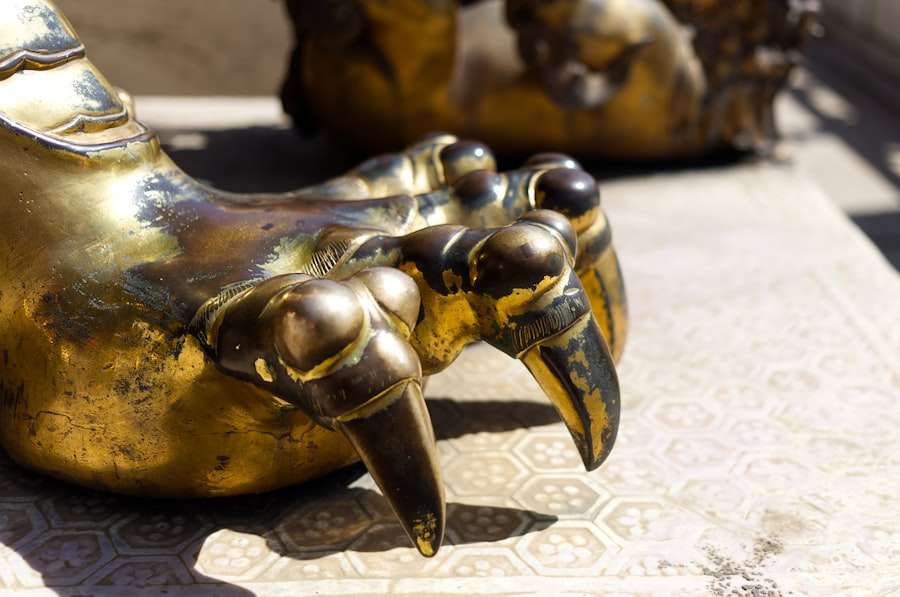What does the jaguar symbolize in Mayan mythology?

The jaguar occupies a prominent position in Mayan mythology, serving as a powerful and enigmatic symbol that has fascinated the Mayan people for millennia. Within Mayan culture, the jaguar is considered a sacred animal, typically associated with attributes such as strength, power, and protection. This feline is also intrinsically linked to concepts of the underworld and nocturnal realms, embodying the mysterious and primal forces of nature.
Additionally, the jaguar represents transformation and rebirth, reflecting the cyclical nature of life and death in Mayan cosmology. An examination of Mayan mythology reveals the jaguar’s multifaceted and enduring significance, which permeates various aspects of Mayan culture.
Key Takeaways
- The jaguar holds a prominent place in Mayan mythology, representing power, strength, and protection.
- In Mayan culture, the jaguar is seen as a symbol of the underworld and the night, associated with darkness and mystery.
- Jaguars are also viewed as guardians and protectors, with the ability to ward off evil spirits and provide safety.
- The jaguar is a symbol of transformation and rebirth, representing the cycle of life and death in Mayan beliefs.
- In Mayan culture, the jaguar is associated with leadership and royalty, embodying the qualities of a strong and authoritative ruler.
- The enduring symbolism of the jaguar in Mayan culture reflects its significance as a powerful and multifaceted symbol in their mythology and beliefs.
The Jaguar as a Symbol of Power and Strength
The Physical Embodiment of Power
In Mayan mythology, the jaguar is revered as a symbol of power and strength, embodying the ferocity and prowess of this majestic creature. The jaguar’s physical attributes, such as its muscular build, sharp claws, and keen senses, have contributed to its association with strength and dominance in Mayan culture. The jaguar’s ability to move swiftly and stealthily through the dense jungles of Mesoamerica further enhances its reputation as a formidable predator, instilling fear and respect in equal measure.
Supernatural Abilities and Spiritual Significance
The Mayans believed that the jaguar possessed supernatural abilities, capable of traversing between the physical and spiritual realms with ease. This perception of the jaguar as a powerful and otherworldly being is reflected in Mayan art and iconography, where the jaguar is often depicted as a fearsome deity or guardian figure, symbolizing the untamed forces of nature. The jaguar’s association with power and strength is also evident in Mayan religious practices and rituals, where the jaguar was venerated as a divine entity with the ability to bestow blessings or curses upon individuals.
Rituals and Symbolism
Shamans and priests would invoke the spirit of the jaguar during ceremonies, seeking its protection and guidance in matters of war, hunting, and spiritual communion. The jaguar’s role as a symbol of power extended beyond the realm of the natural world, permeating every aspect of Mayan society, from rulership and governance to warfare and spiritual enlightenment. As such, the jaguar became an emblem of authority and influence, embodying the inherent strength and resilience of the Mayan people.
The Jaguar as a Symbol of the Underworld and the Night

In addition to its association with power and strength, the jaguar holds a prominent place in Mayan mythology as a symbol of the underworld and the night. The Mayans believed that the jaguar was closely linked to the realm of Xibalba, the dark and foreboding underworld inhabited by malevolent deities and ancestral spirits. As a nocturnal predator, the jaguar was seen as a guardian of the night, prowling through the shadows with an air of mystery and intrigue.
The Mayans revered the jaguar as a potent symbol of darkness and primordial forces, representing the enigmatic aspects of existence that lie beyond the realm of human comprehension. The jaguar’s association with the underworld and the night is further emphasized in Mayan religious cosmology, where it is often depicted as a fearsome deity presiding over the realm of death and rebirth. The jaguar’s role as a guardian of the night was also reflected in Mayan art and architecture, where intricate carvings and sculptures featuring jaguar motifs adorned sacred temples and burial sites.
These depictions served as a reminder of the jaguar’s enduring presence in both the physical and spiritual realms, underscoring its significance as a symbol of the mysterious and unknowable aspects of existence. As such, the jaguar became an emblem of transcendence and transformation, guiding souls through the perilous journey into the afterlife.
The Jaguar as a Symbol of Protection and Guardianship
Beyond its association with power and the underworld, the jaguar holds a profound significance in Mayan culture as a symbol of protection and guardianship. The Mayans revered the jaguar as a benevolent guardian spirit, capable of warding off malevolent forces and ensuring the safety of individuals and communities. The jaguar’s formidable reputation as a fierce and tenacious predator made it an ideal symbol of protection, instilling a sense of security and reassurance among the Mayan people.
The jaguar was often invoked in rituals and ceremonies aimed at seeking its divine protection, particularly during times of hardship or adversity. The jaguar’s role as a symbol of protection is also evident in Mayan folklore and oral traditions, where it is often portrayed as a benevolent deity watching over humanity with unwavering vigilance. Tales of heroic jaguars defending villages from marauding enemies or rescuing lost travelers from perilous situations were passed down through generations, reinforcing the jaguar’s status as a revered guardian figure.
The Mayans believed that by invoking the spirit of the jaguar, they could harness its protective energies to shield themselves from harm and misfortune. This deep-seated belief in the jaguar’s protective powers permeated every aspect of Mayan society, shaping their worldview and instilling a profound reverence for this majestic creature.
The Jaguar as a Symbol of Transformation and Rebirth
In addition to its role as a protector and guardian, the jaguar holds a symbolic significance in Mayan mythology as a representation of transformation and rebirth. The Mayans believed that the jaguar possessed the ability to transcend boundaries between different realms, embodying the cyclical nature of life, death, and regeneration. The jaguar’s association with transformation is rooted in its enigmatic nature as a creature that effortlessly navigates between light and darkness, life and death, embodying the eternal cycle of existence.
This duality is reflected in Mayan art and iconography, where the jaguar is often depicted with intricate patterns symbolizing its transformative powers. The concept of transformation is deeply ingrained in Mayan religious beliefs, where rituals and ceremonies were conducted to honor the jaguar as a symbol of renewal and regeneration. The Mayans believed that by aligning themselves with the spirit of the jaguar, they could undergo profound personal transformations, shedding their old selves to embrace new beginnings.
The jaguar’s association with transformation also extended to its role in guiding souls through the perilous journey into the afterlife, ensuring their safe passage into the realm of ancestors. As such, the jaguar became an emblem of spiritual metamorphosis, inspiring individuals to embrace change and embrace new opportunities for growth.
The Jaguar as a Symbol of Leadership and Royalty

Symbolism in Mayan Art and Politics
Kings and nobles were often depicted wearing elaborate headdresses adorned with jaguar motifs, signifying their divine right to rule with wisdom and strength. The association between the jaguar and leadership is also evident in Mayan political structures, where rulers were often referred to by titles incorporating references to the jaguar. These titles served to emphasize their connection to divine authority and their role as protectors of their people.
Spiritual Significance
The jaguar’s symbolic significance as a representation of leadership extended beyond earthly realms into spiritual dimensions, where it was venerated as a celestial deity guiding rulers with wisdom and foresight. As such, the jaguar became an emblem of sovereignty and nobility, inspiring reverence and admiration among the Mayan populace.
A Symbol of Sovereignty and Nobility
In Mayan culture, the jaguar’s majestic image was synonymous with power, wisdom, and leadership. Its revered status was a testament to the Mayans’ deep respect for the natural world and their ability to draw inspiration from it. The jaguar’s enduring legacy as a symbol of sovereignty and nobility continues to captivate and inspire people to this day.
The Enduring Symbolism of the Jaguar in Mayan Culture
In conclusion, the jaguar holds an enduring significance in Mayan culture as a multifaceted symbol representing power, strength, protection, transformation, leadership, and royalty. Its enigmatic nature as a creature embodying both light and darkness has captivated the imagination of the Mayan people for centuries, permeating every aspect of their mythology, religion, art, and societal structures. The jaguar’s profound symbolism reflects the complex worldview of the Mayans, encapsulating their deep-seated reverence for nature’s primal forces and their belief in transcending boundaries between different realms.
The enduring legacy of the jaguar in Mayan culture serves as a testament to its timeless appeal as a symbol that continues to inspire awe and fascination in contemporary times. Its representation as a guardian figure watching over humanity with unwavering vigilance resonates with our innate desire for protection and security in an unpredictable world. Its association with transformation reminds us of our capacity for personal growth and renewal in times of adversity.
Its symbolism as a representation of leadership underscores our aspirations for wisdom and nobility in guiding others towards prosperity. Ultimately, the enduring symbolism of the jaguar in Mayan culture serves as a poignant reminder of our interconnectedness with nature’s primal forces and our eternal quest for meaning and transcendence in our journey through life. As we continue to unravel the mysteries surrounding this majestic creature, we are reminded of its timeless allure that transcends cultural boundaries and resonates with our shared human experience.
FAQs
What is the significance of the jaguar in Mayan mythology?
The jaguar holds great significance in Mayan mythology as a symbol of power, strength, and agility. It is often associated with the underworld and the night, and is considered a sacred and powerful animal.
How is the jaguar depicted in Mayan art and architecture?
In Mayan art and architecture, the jaguar is often depicted as a fearsome and majestic creature. It is commonly seen in carvings, sculptures, and paintings, and is often portrayed with distinctive features such as sharp teeth, powerful muscles, and a fierce expression.
What role does the jaguar play in Mayan religious beliefs?
The jaguar is believed to have played a significant role in Mayan religious beliefs, often being associated with deities and supernatural forces. It is considered a guardian of the underworld and a symbol of the night, and is often linked to rituals and ceremonies.
Are there specific Mayan gods or deities associated with the jaguar?
Yes, there are several Mayan gods and deities that are associated with the jaguar. One prominent example is the god of the underworld, known as the “Jaguar God of the Underworld” or “God L.” This deity is often depicted as a jaguar or a human figure with jaguar features.
How does the jaguar symbolize power and authority in Mayan culture?
The jaguar is seen as a symbol of power and authority in Mayan culture due to its strength, agility, and fearsome reputation. It is often associated with rulers, warriors, and elite members of society, and is considered a symbol of leadership and dominance.





